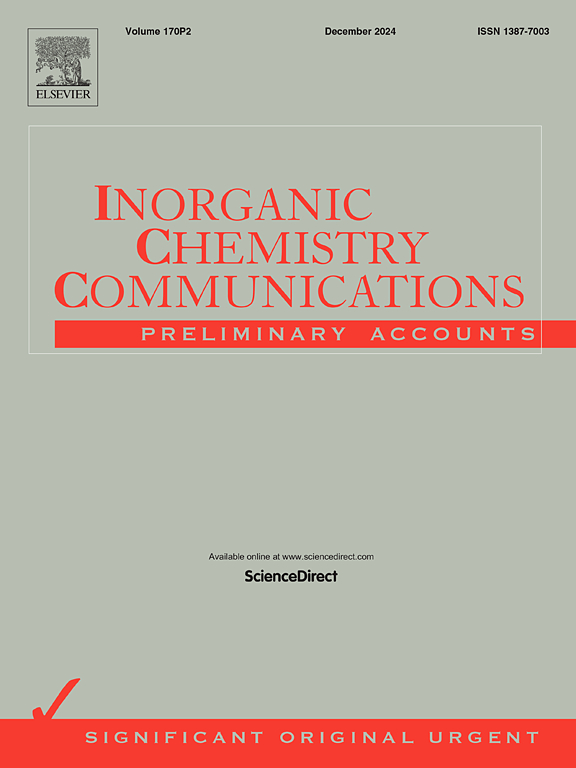Constructing visible-light-driven heterojunctions NiS/ZnO photocatalyst for H2 evolution by glycerol photoreforming
IF 4.4
3区 化学
Q1 CHEMISTRY, INORGANIC & NUCLEAR
引用次数: 0
Abstract
The incorporation of NiS as a cocatalysts can effectively boost the separation of photocharge carriers in NiS/ZnO photocatalyst for promoting the H2 evolution yield. Herein, mesoporous ZnO nanoparticles (NPs), with an average particle size of ∼ 10 nm, were hydrothermally synthesized in the presence of tetrapropylammonium hydroxide (TPAOH). NiS NPs (10 nm) as a cocatalyst are uniformly distributed on the mesoporous ZnO NPs. The photocatalytic activity of xNiS/ZnO (x = 3, 6, 9, and 12 wt%), as a photocatalyst, are evaluated for H2 evolution through photoreforming of glycerol under visible light illumination of λ ≥ 420 nm. A small amount of the platinum (0.5 %, w/w) was photodeposited onto NiS/ZnO nanocomposites under illumination during the photocatalytic process. The 9 % NiS/ZnO photocatalyst showed the maximum H2 evolution rate of ∼3078.3μmol g−1h−1, which was improved by 108 folds over sole ZnO NPs (28.42μmol g−1h−1). The NiS/ZnO nanocomposites offered sufficient stable H2 evolution rate for five cycles within 45 h. The enhancement of the photocatalytic activity of NiS/ZnO nanocomposites was verified by photoluminescence, which was confirmed by the photocurrent-time results. The enhanced H2 evolution from glycerol photoreforming over NiS/ZnO nanocomposites was ascribed to their high surface area, high crystallinity and narrowed bandgap energy, formation of Schottky barriers, high light harvesting, and the accelerated separation of the photocharge carriers. This work highlights the novel design of low-cost photocatalysts for realizing considerable H2 evolution yield under visible illumination.

甘油光重整制备可见光异质结NiS/ZnO析氢催化剂
在NiS/ZnO光催化剂中加入NiS作为助催化剂可以有效地促进光电荷载流子的分离,从而提高析氢收率。在四丙基氢氧化铵(TPAOH)的存在下,水热合成了平均粒径为~ 10 nm的介孔ZnO纳米颗粒(NPs)。作为助催化剂的NPs (10 nm)均匀分布在介孔ZnO NPs上。研究了xNiS/ZnO (x = 3、6、9和12 wt%)作为光催化剂,在λ≥420 nm的可见光照射下,对甘油光重整制氢的光催化活性进行了评价。在光催化过程中,少量的铂(0.5%,w/w)在光照下沉积在NiS/ZnO纳米复合材料上。9% NiS/ZnO光催化剂的最大析氢速率为~ 3078.3μmol g−1h−1,比单一ZnO NPs (28.42μmol g−1h−1)提高了108倍。NiS/ZnO纳米复合材料在45 h内的5个循环中具有足够稳定的析氢速率。通过光致发光验证了NiS/ZnO纳米复合材料的光催化活性增强,光电流-时间结果也证实了这一点。甘油光重整在NiS/ZnO纳米复合材料上的H2析出增强归因于其高表面积、高结晶度和窄带隙能量、Schottky势垒的形成、高光收获以及光荷载流子的加速分离。这项工作强调了低成本光催化剂的新设计,可以在可见照明下实现可观的氢析收率。
本文章由计算机程序翻译,如有差异,请以英文原文为准。
求助全文
约1分钟内获得全文
求助全文
来源期刊

Inorganic Chemistry Communications
化学-无机化学与核化学
CiteScore
5.50
自引率
7.90%
发文量
1013
审稿时长
53 days
期刊介绍:
Launched in January 1998, Inorganic Chemistry Communications is an international journal dedicated to the rapid publication of short communications in the major areas of inorganic, organometallic and supramolecular chemistry. Topics include synthetic and reaction chemistry, kinetics and mechanisms of reactions, bioinorganic chemistry, photochemistry and the use of metal and organometallic compounds in stoichiometric and catalytic synthesis or organic compounds.
 求助内容:
求助内容: 应助结果提醒方式:
应助结果提醒方式:


